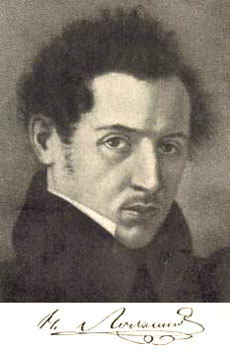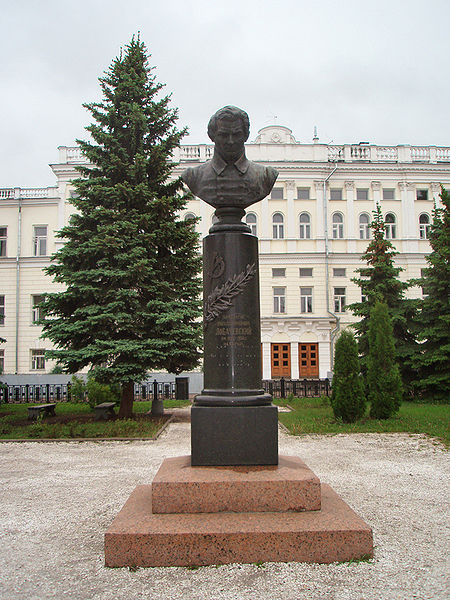<Back to Index>
- Mathematician Nikolai Ivanovich Lobachevsky, 1792
- Architect Minoru Yamasaki, 1912
- Marshal of the Soviet Union Georgy Konstantinovich Zhukov, 1896
PAGE SPONSOR


Nikolai Ivanovich Lobachevsky (Russian: Никола́й Ива́нович Лобаче́вский) (December 1, 1792 – February 24, 1856 (N.S.); November 20, 1792 – February 12, 1856 (O.S.)) was a Russian mathematician, sometimes called the Copernicus of geometry.
Lobachevsky was born in Nizhny Novgorod, Russia. His parents were Ivan Maksimovich Lobachevsky, a clerk in a land surveying office, and Praskovia Alexandrovna Lobachevskaya. In 1800, his father died, and his mother moved to Kazan. In Kazan, Lobachevsky attended Kazan Gymnasium, graduating in 1807 and then Kazan University, which was founded just three years earlier in 1804. At Kazan University, Lobachevsky was influenced by professor Johann Christian Martin Bartels (1769 – 1833), a former teacher and friend of German mathematician Carl Friedrich Gauss. Lobachevsky received a Master's degree in physics and mathematics in 1811. In 1814, he became a lecturer at Kazan University, and, in 1822, he became a full professor, teaching mathematics, physics, and astronomy. He served in many administrative positions and became the rector of Kazan University in 1827. In 1832, he married Varvara Alexeivna Moisieva. They had a large number of children (the exact number appears to be unknown, though the number fifteen is most commonly quoted); however, only three of them survived into adulthood. He retired (or was dismissed) from the university in 1846, ostensibly due to his deteriorating health: by the early 1850s, he was nearly blind and unable to walk. He died in poverty in 1856.
Lobachevsky's main achievement is the development (independently from János Bolyai) of a non-Euclidean geometry, also referred to as Lobachevskian geometry. Before him, mathematicians were trying to deduce Euclid's fifth postulate from other axioms. Euclid's fifth is a rule in Euclidean geometry which states (in John Playfair's reformulation) that for any given line and point not on the line, there is one parallel line through the point not intersecting the line. Lobachevsky would instead develop a geometry in which the fifth postulate was not true. This idea was first reported on February 23 (Feb. 11, O.S.), 1826 to the session of the department of physics and mathematics, and this research was printed in the UMA (Вестник Казанского университета) in 1829 – 1830. Lobachevsky wrote a paper about it called A concise outline of the foundations of geometry that was published by the Kazan Messenger but was rejected when it was submitted to the St. Petersburg Academy of Sciences for publication.
The non-Euclidean geometry that Lobachevsky developed is referred to as hyperbolic geometry.
Lobachevsky replaced Euclid's parallel postulate with the one stating
that there is more than one line that can be extended through any given
point parallel to another line of which that point is not part; a
famous consequence is that the sum of angles in a triangle must be less than 180 degrees. Non-Euclidean geometry is now in common use in many areas of mathematics and physics, such as general relativity; and hyperbolic geometry is now often referred to as "Lobachevskian geometry" or "Bolyai-Lobachevskian geometry". Some
mathematicians and historians have wrongfully claimed that Lobachevsky
stole his concept of non-Euclidean geometry from Gauss, which is untrue
- Gauss himself appreciated Lobachevsky's published works very highly,
but they never had personal correspondence between them prior to the
publication. In fact out of the three people that can be credited with
discovery of hyperbolic geometry - Gauss, Lobachevsky and Bolyai,
Lobachevsky rightfully deserves having his name attached to it, since
Gauss never published his ideas and out of the latter two Lobachevsky
was the first who duly presented his views to the world mathematical
community. Lobachevsky's magnum opus Geometriya was
completed in 1823, but was not published in its exact original form
until 1909, long after he had died. Lobachevsky was also the author of New Foundations of Geometry (1835 - 1838). He also wrote Geometrical Investigations on the Theory of Parallels (1840) and Pangeometry (1855). Another of Lobachevsky's achievements was developing a method for the approximation of the roots of algebraic equations. This method is now known as the Dandelin–Gräffe method,
named after two other mathematicians who discovered it independently.
In Russia, it is called the Lobachevsky method. Lobachevsky gave the
definition of a function as a correspondence between two sets of real numbers (Dirichlet gave the same definition independently soon after Lobachevsky).